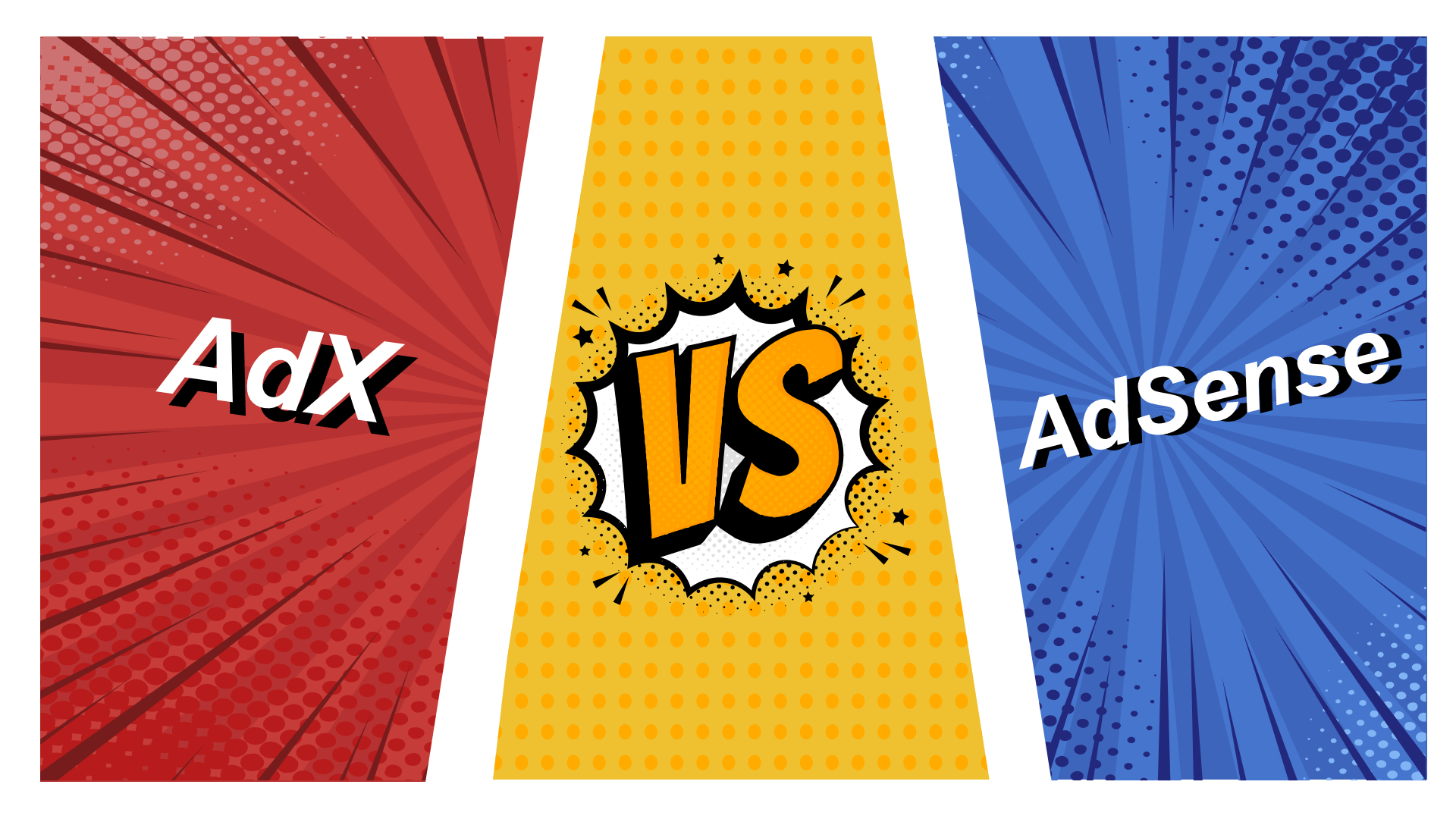AdSense vs. AdX. Which Platform Is Better for Publishers?
May 20, 2021
One of the most typical challenges and issues publishers are facing when choosing a digital advertising platform to monetize their content with is comparing AdX vs AdSense. Which one is more functional or able to bring higher ad revenues?
Differentiating AdX from AdSense can be confusing, especially for those publishers who are not very experienced. Both platforms are owned by Google and are part of the Internet giant’s advertising portfolio. Both AdSense and AdX allow publishers to monetize their content.
What’s the difference between these two and which one is more relevant for your websites? These are the natural questions to ask here. Today we are going to address the ‘AdX vs. AdSense’ topic in our usual manner: trying to provide short, easy to digest and most relevant information that would help gain a clearer understanding of the essence of these tools and how they can be utilised with highest benefit.
What are AdX and AdSense?

Let’s begin with some basic information about these platforms in order for you to get a clearer understanding.
-
What is Google Ad Exchange (AdX)?
Google AdX is an ad exchange network for publishers, advertisers and agencies that offers programmatic real-time bidding on its massive ad inventory. This includes multiple networks and Demand Side Platforms (DSPs).
Google AdX was originally known as DoubleClick Ad Exchange, is operated by the DoubleClick company, founded in 1995. In 2008 DoubleClick was acquired by Google for a whopping $3.1 billion in a highly controversial deal that sparked a lot of concern about the Internet giant getting too much power over the digital advertising market.
Eventually Google renamed DoubleClick’s two main products, DoubleClick for Publishers (DFP) and DoubleClick Ad Exchange (AdX), and turned them into Google Ad Manager ad platform. Today AdX remains a part of Google Ad Manager.
-
What is Google AdSense?
AdSense is an ad network that allows publishers to monetize their content by serving text, images, video and interactive media advertisements. Developed as Google’s internal product and launched in 2003, AdSense works by matching ads to publishers’ sites based on the content and visitors. The ads are created and paid for by advertisers who want to promote their products. Advertising for AdSense partners comes from other ad services by Google such as Google Ads (formerly Google AdWords) and Google Display Network.
AdX and AdSense: not the same

When it comes to general popularity, which, of course, shouldn’t be viewed as a decisive criterion when making the choice, AdSense is considerably more popular, and it makes sense as this platform is more accessible to publishers with smaller audiences.
Despite very similar purposes for publishers, essentially AdX and AdSense are not the same kinds of digital advertising platforms.
-
AdSense is an ad network.
Ad networks aggregate ad spaces from various publishers on their platforms and sell them to ad buyers for a commission. Ad network’s function is to collect ad supply and match it with demand from advertisers.
-
AdX is an ad exchange.
Ad exchanges are similar to ad networks in what they do: connecting publishers with ad inventory to advertisers and ad buyers. The difference is that ad exchanges allow advertisers and publishers to trade directly on their marketplaces, with deals taking place during real-time auctions powered by RTB (real-time bidding) technology.
So the general similarity of AdX and AdSense, and the fact that they are both suitable for publishers looking to monetize their ad inventory, should not confuse you. As after all, they are two different parts of the ad technology stack, along with multiple other tools.
To put it in even simpler terms, Google AdX is a sophisticated programmatic advertising platform mostly meant for larger publishers. AdSense is a self-managed platform serving low-cost ads that is easy to set up and requires minimum effort from a publisher.
Here’s what Google itself has to say about choosing between AdX and AdSense: “While both provide access to millions of buyers, Ad Manager is built for publishers that require granular controls to avoid undermining their direct sales efforts. If you don’t have a significant direct sales business or if channel conflict is not a major concern for you, AdSense might be a better solution.”
AdX vs. AdSense: differences

Now, after we have covered the fundamental distinction between these two, let’s dive into differences between AdSense and AdX.
-
Minimum pageviews requirement.
- AdX requires publishers to have a minimum of 5 million monthly pageviews.
- AdSense has no minimum pageviews requirement.
-
Ad space and bidding control.
- AdX gives publishers more control over their ad inventory and bidding. Publishers can pick a way of dealing with advertisers, choosing between private auctions with floor price or fixed CPM.
- AdSense provides publishers with limited controls over the ad space and bidding. It only allows them to choose how many ads will be displayed on each website. While all the other things are taken care of by the service automatically.
-
Set up process.
- AdX has a more complex set up process requiring time and some basic knowledge of the programmatic advertising domain.
- AdSense has a very easy set up process that can be done just in a few minutes.
-
Advertisers and agencies.
- AdX allows all vendors to use the platform, but publishers are able to block vendors and have access to advertisers from other marketplaces.
- Google AdSense allows certified vendors and publishers to a limited selection from Google Ads and Google Display Network.
-
Tools for publishers.
- AdX offers an advanced set of tools meant for publishers that are experienced in programmatic advertising.
- AdSense has a basic selection of tools, and you don’t need any special knowledge to utilise them.
Summary: which one to choose?

Naturally, AdX is a better platform if viewed solely from the monetization point of view. Real-time bidding, deal customization and access to more vendors allow publishers to generate more revenue.
AdSense, on the other hand, is focused on accessibility to publishers of all sizes, providing low-cost impressions to advertisers. Since AdSense doesn’t allow publishers to set a floor prices, publishers have no control over the dealing process. This results in your ad inventory generating a smaller revenue.
So when it comes to choosing between these two platforms, it really boils down to the size. AdX, accepting only large publishers with 5 million monthly pageviews or more, in most cases will be your go-to choice. You would also need some adtech knowledge or a qualified programmatic ads expert to get the most out of using this platform. AdSense is a simpler and less profitable solution that is meant for small and medium-sized publishers who are below the 5 million monthly pageviews mark.
Talking about qualified programmatic ads experts, this is us. And getting the most out of ad exchanges such as AdX is what we do best. Our ad ops specialists are well-versed in the best practices and trends of the industry. We can help you to set up, optimize and manage your ad inventory to maximize the ad revenues.
Get in touch with pubGENIUS Team to get free consultation 🙂
.
